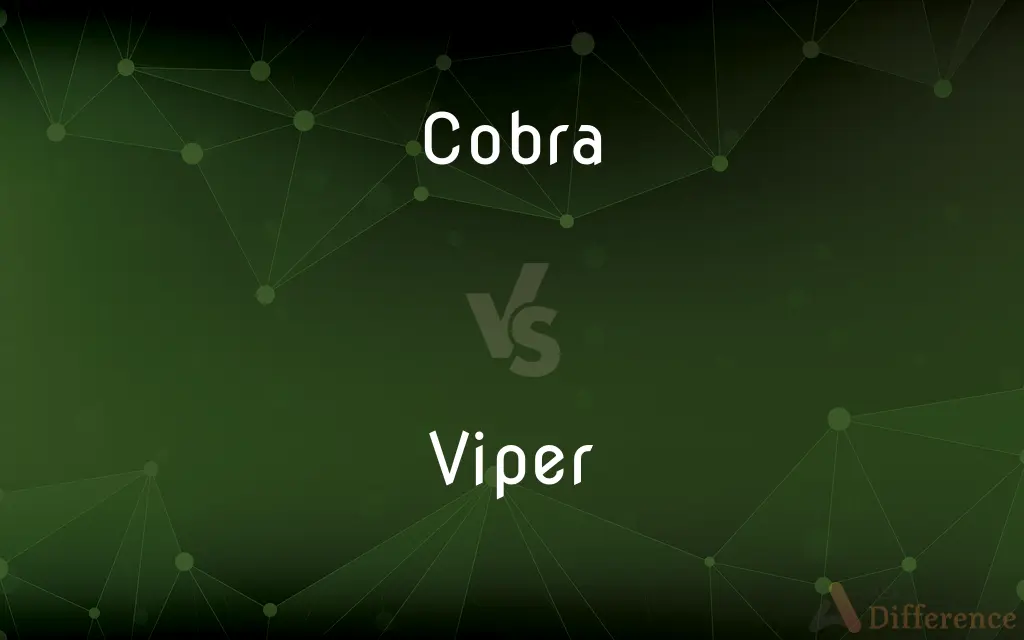Cobra vs. Viper — What's the Difference?
Edited by Tayyaba Rehman — By Urooj Arif — Updated on April 4, 2024
Cobras, known for their iconic hoods and intimidating posture, are venomous snakes primarily found in Asia and Africa, while vipers are distinguished by their long fangs and potent venom, inhabiting various global regions.

Difference Between Cobra and Viper
Table of Contents
ADVERTISEMENT
Key Differences
Cobras are famous for their distinctive hood, created by the elongation of ribs behind their heads, which they flare when threatened, serving as a warning. This hood is part of their unique threat display, making them one of the most easily recognizable snakes in the world. On the other hand, vipers are known for their sophisticated venom delivery system. They possess long, hinged fangs that allow them to inject venom deeply into their prey. The viper's fangs fold back when not in use, allowing for more efficient and safer venom delivery compared to the relatively fixed fangs of cobras.
While cobras have a more uniform body shape with smooth scales, vipers' bodies can vary significantly across species, often featuring keeled scales that give them a rough appearance. This physical distinction contributes to their different habitats and camouflage strategies, with cobras generally favoring open areas and vipers blending into more varied and sometimes rugged terrains.
Cobras have a more diverse range of venom effects, including neurotoxins that can affect the nervous system and cytotoxins that cause tissue damage. This makes their venom particularly dangerous to humans and their prey. Vipers, however, primarily rely on hemotoxins that disrupt blood clotting and cause organ degeneration, leading to a slow but fatal outcome for their victims.
Behaviorally, cobras are known for their ability to raise a significant portion of their bodies off the ground and even move forward in this position. This behavior not only aids in their threat display but also allows them to scan their surroundings for threats or prey. Vipers lack this ability and are more reliant on their camouflage and sudden strikes from a coiled position to capture prey or deter predators.
Comparison Chart
Physical Trait
Iconic hood and smooth scales
Long, hinged fangs and often keeled scales
ADVERTISEMENT
Venom Delivery
Fixed fangs deliver neurotoxins and cytotoxins
Hinged fangs allow deep injection of primarily hemotoxins
Body Shape
More uniform shape
Body shape varies significantly among species
Habitat
Prefer open areas in Asia and Africa
Found in varied terrains globally
Behavior
Can raise their body and move in an upright position
Rely on camouflage and striking from a coiled position
Compare with Definitions
Cobra
They are revered in many cultures.
In Egyptian mythology, the cobra is seen as a protective symbol.
Viper
Vipers are found worldwide.
The common adder, a type of viper, is the only venomous snake in Britain.
Cobra
They primarily inhabit Asia and Africa.
Cobras are often encountered in the agricultural fields of India.
Viper
Their camouflage is highly effective.
The horned viper blends seamlessly with the desert sands.
Cobra
Cobras possess neurotoxic venom.
The neurotoxin in cobra venom can cause paralysis in its victims.
Viper
Vipers have long, hinged fangs.
The viper extended its fangs to inject venom into its prey.
Cobra
Cobras are venomous snakes known for their hood.
The Indian cobra spread its hood as a warning when it felt threatened.
Viper
They exhibit a wide range of body forms.
The pit viper has a distinctive heat-sensing pit between its eyes and nostril.
Cobra
Some species can spit venom.
The spitting cobra can accurately project its venom at the eyes of its aggressors.
Viper
Any of various venomous snakes of the family Viperidae, having a thick heavy body and a single pair of long hollow fangs, especially the Eurasian and African species of the subfamily Viperinae, which lack the sensory pits of the pit vipers.
Cobra
Cobra is the common name of various elapid snakes, most of which belong to the genus Naja.
Viper
Any of several harmless snakes sometimes believed to be venomous.
Cobra
Any of various venomous elapid snakes, especially of the genus Naja, that are native to Asia and Africa and are capable of expanding the skin of the neck to form a flattened hood.
Viper
A person regarded as malicious or treacherous.
Cobra
Leather made from the skin of one of these snakes.
Viper
A venomous snake in the family Viperidae.
Cobra
Any of various venomous snakes of the family Elapidae.
Viper
(informal) Any venomous snake.
Cobra
A type of lanyard knot, thought to resemble a snake in its shape.
Viper
(figurative) A dangerous, treacherous, or malignant person.
Cobra
See Copra.
Viper
(slang) A person who smokes marijuana.
Cobra
The cobra de capello.
Viper
Any one of numerous species of Old World venomous snakes belonging to Vipera, Clotho, Daboia, and other genera of the family Viperidæ.
There came a viper out of the heat, and fastened on his hand.
Cobra
Venomous Asiatic and African elapid snakes that can expand the skin of the neck into a hood
Viper
A dangerous, treacherous, or malignant person.
Who committedTo such a viper his most sacred trustOf secrecy.
Viper
Loosely, any venomous or presumed venomous snake.
Viper
Venomous Old World snakes characterized by hollow venom-conducting fangs in the upper jaw
Common Curiosities
Are all cobras capable of spitting venom?
Not all cobras can spit venom; this ability is specific to certain species like the spitting cobra.
Can cobras live outside of Asia and Africa?
While cobras are native to Asia and Africa, some can live in captivity or introduced environments outside these continents.
What makes a cobra's hood unique?
A cobra's hood is created by the elongation of ribs behind their head, which they can flare.
How do cobras and vipers reproduce?
Both cobras and vipers lay eggs, but some viper species give birth to live young.
What is the primary diet of cobras?
Cobras mainly feed on small mammals, birds, and other snakes.
Are cobras revered in any cultures?
Yes, cobras are often revered in various cultures, such as in Egyptian mythology where they symbolize protection.
How do vipers inject their venom?
Vipers use long, hinged fangs that fold back when not in use to inject venom deeply.
How do cobras defend themselves?
Cobras may raise their bodies, spread their hoods, and hiss to intimidate threats or predators.
Can viper bites be treated?
Yes, with prompt medical treatment including antivenom, the effects of viper bites can be managed.
Is it safe to handle a viper or cobra without training?
No, handling any venomous snake without proper training and equipment is extremely dangerous.
What habitats do vipers prefer?
Vipers can inhabit a wide range of environments, from deserts to forests, depending on the species.
Share Your Discovery

Previous Comparison
Viscoelastic vs. Viscoplastic
Next Comparison
Lap vs. SleepAuthor Spotlight
Written by
Urooj ArifUrooj is a skilled content writer at Ask Difference, known for her exceptional ability to simplify complex topics into engaging and informative content. With a passion for research and a flair for clear, concise writing, she consistently delivers articles that resonate with our diverse audience.
Edited by
Tayyaba RehmanTayyaba Rehman is a distinguished writer, currently serving as a primary contributor to askdifference.com. As a researcher in semantics and etymology, Tayyaba's passion for the complexity of languages and their distinctions has found a perfect home on the platform. Tayyaba delves into the intricacies of language, distinguishing between commonly confused words and phrases, thereby providing clarity for readers worldwide.














































